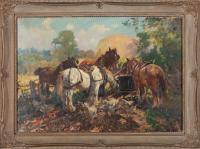Estimate: $10,000/$15,000
Though largely self-taught, Harold Septimus Power achieved admirable
results in local art competitions during his youth. He won silver medals at
the Collingwood Junior Exhibition in 1896 and 1899, and a gold medal at the
Melbourne Art Club in 1899.
...
His first formal art education took place in Paris from 1905 to 1907, where
he studied at the Académie Julian under Jean-Paul Laurens. Prior to this,
he had received encouragement from the notable artist Walter Withers, as
well as reluctant support from his father, Peter Power - a painting teacher
in Brunswick - who was hesitant for his son to follow in his artistic
footsteps.
Power was a versatile artist, skilled in portraiture, still life, and
landscapes, but his true passion was for animals - horses in particular.
Whether painting dogs, cats, camels, or birds, no creature from the animal
kingdom proved too challenging for him. He was widely regarded as
Australia’s premier painter of animals, possessing an innate ability to
capture not only the physical likeness but also the spirit and individual
character of his subjects - whether they were feeding, working, playing, or
simply at rest.
He lived and worked in London for many years, earning numerous commissions
for equestrian portraits and regularly exhibiting at the Royal Academy.
Although a hearing impairment disqualified him from active service during
World War I, he was appointed as an official Australian war artist and
often worked under enemy fire. It was said that his hearing loss allowed
him to concentrate amid the chaos of battle. The Australian War Memorial
holds more than 60 of his works, most of them painted in France, with
others completed after his return to Australia.
His work is included in all Australian state gallery collections, the
National collection in Canberra and the Imperial War Museum in London.
Read more


